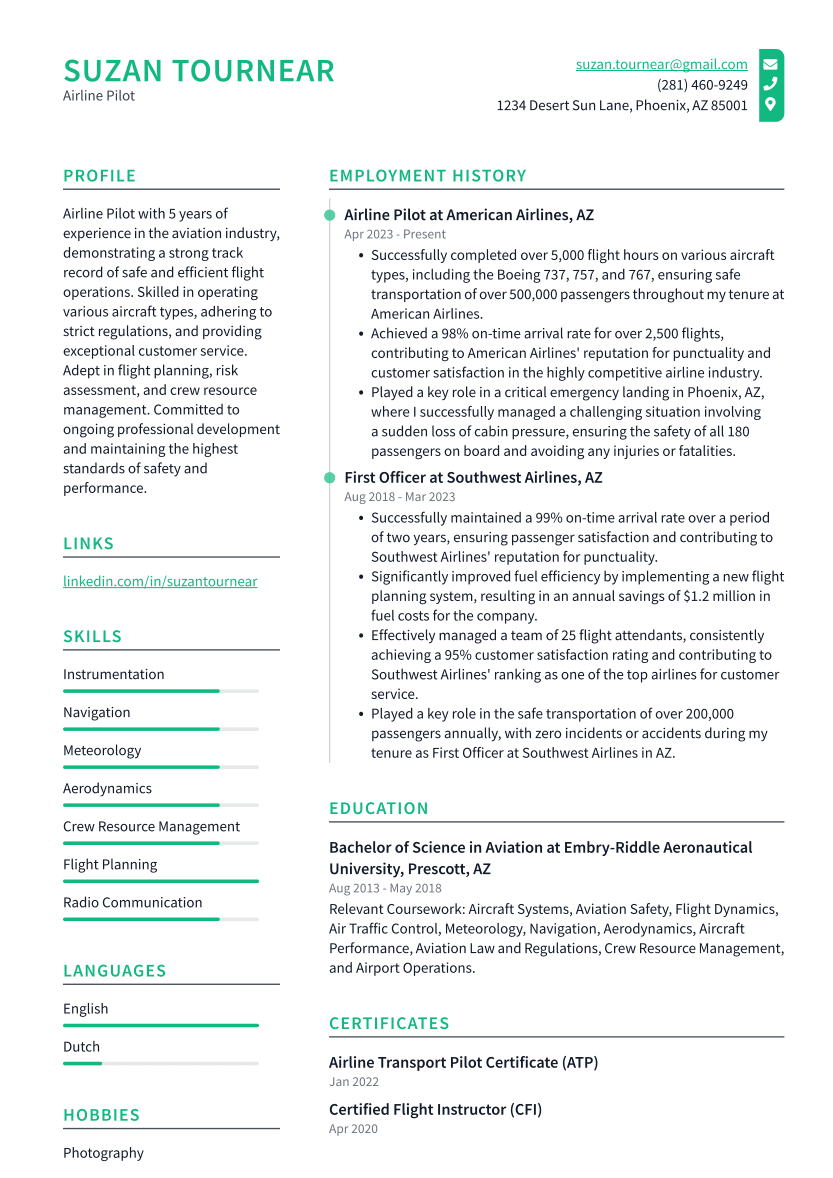Airline Pilot Resume Examples
Writing a great airline pilot resume is important because it is one of the first things a potential employer will see when they are considering you for a position. It is your opportunity to make a good first impression and sell yourself as the best candidate for the job.
Create your resume
Select from 7 professional resume templates
If you're looking for inspiration when it comes to drafting your own airline pilot resume, look no further than the samples below. These resumes will help you highlight your experience and qualifications in the most effective way possible, giving you the best chance of landing the airline pilot job you're after.
Essential Components of an Airline Pilot Resume
An exceptional airline pilot resume is a critical tool for landing your dream position. It serves as your professional introduction, offering a first impression to potential employers and highlighting your skills, qualifications, and experience in aviation. A meticulously crafted resume distinguishes you from the competition and increases your chances of receiving an interview invitation. In this guide, we will explore the essential elements of an airline pilot resume, including the necessary sections, what to include in each, and tips for making your resume shine.
1. Contact Information
Begin your resume with your contact information, ensuring it's accurate and up-to-date. This section should include your full name, phone number, professional email address, and location (city and state).

Consider adding links to professional online profiles, such as LinkedIn, or a personal website showcasing your career achievements. For international applicants or those with global experience, include country codes with phone numbers and list any additional languages spoken.
Keep this section concise; its primary purpose is to provide contact details, not extensive information.
2. Objective Statement
The Objective Statement is a brief yet impactful introduction placed at the top of your resume. It should succinctly convey your career goals and how you intend to contribute to the airline.
Highlight your most pertinent skills, qualifications, and experiences, tailoring your statement to align with the airline's mission and values. For example: "Commercial pilot with over 5,000 flight hours seeking to leverage my expertise in aviation safety and customer service in a dynamic airline pilot role."
Research the airline to personalize your objective, making it resonate with the hiring manager and encouraging them to read further.
3. Flight Hours and Certifications
Emphasize your Flight Hours and Certifications, as these are critical indicators of your expertise and eligibility. Detail your total flight hours, types of aircraft flown, and all relevant certifications, ensuring they are current and valid.
Include basic licenses like the Private Pilot License (PPL), as well as advanced qualifications such as the Commercial Pilot License (CPL) or Airline Transport Pilot License (ATPL). Additional ratings and certifications can set you apart, demonstrating specialized skills and a commitment to safety.
4. Work Experience/Flight Experience
The Work Experience/Flight Experience section is where you outline your professional background. List each position, including the aircraft types, hours flown, routes, and responsibilities. Highlight any notable achievements or recognitions.
Include any relevant ground-based roles in aviation, as these experiences contribute to a comprehensive understanding of the industry and can enhance your appeal to employers.
5. Skills and Abilities
The Skills and Abilities section showcases your technical and soft skills. List abilities such as knowledge of aviation regulations, weather pattern comprehension, proficiency with flight instruments, and emergency management.
Also, emphasize soft skills like communication, decision-making, leadership, stress management, multitasking, attention to detail, problem-solving, and language proficiency, particularly in English.
Customize this section to reflect the skills most valued by the airline you are applying to.
6. Education/Training
The Education/Training section should detail your formal education, pilot training programs completed, and any additional specialized training. This includes degrees in relevant fields, pilot licenses, ratings, and flight hours accumulated during training.
Specialized training in areas like Crew Resource Management (CRM) or Aviation Security can also be highlighted to demonstrate your preparedness for emergency situations and teamwork.
7. References
While not always required, the References section can be a valuable addition to your resume. Choose individuals who can attest to your piloting capabilities and professional demeanor.
Provide complete contact information for each reference and a brief description of your relationship. Aim for three to five reliable references who can offer detailed and positive feedback about your qualifications and work ethic.
By incorporating these key elements into your airline pilot resume, you'll present a compelling and comprehensive profile that captures the attention of hiring managers and positions you as an ideal candidate for the role.
